Iakov Levi
The Chariot of the
Sun and the Messiah
August 17, 2005
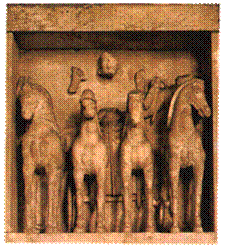
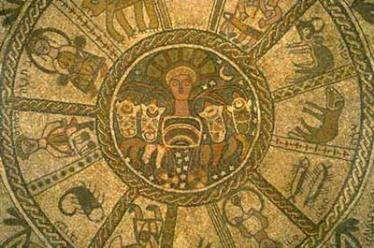
The Metope of Selinunte
The Mosaic
at Beith Alpha
(
1200 years separate between
the two artistic representations of the chariot of the sun. The first is a
relief on a Greek temple in
The mosaic at Beith Alpha
represents a provincial expression of art. It is quite naive and very far from
the apex of artistic expressions achieved during this period in the capital of
the empire, as well as in San Vitale in
What is odd and peculiar is
that it does not belong to a pagan temple or to a church, but to a synagogue.
The Jews were not supposed to decorate synagogues with symbols of a Sun- god.
It is not the only case in
which synagogues were decorated with anthropomorphic representations. There are
other cases in Galilee, as at Korazin, where image of Medusa's head was carved on
an architrave (4th century A.D.), and at Doura Europos, where
images of Patriarchs were frescoed on the
walls (third century A.D.).
I shall focus on the mosaic at
Beith Alpha because it represents the chariot of the sun, which is a central
theme in western art, from archaic
Who is the Sun, and what does
it mean?
In astrology, the sun is
usually represented as a lion. Karl Abraham, who analyzed the myth of Samson
and his struggle with a lion, has drawn the conclusion that the psychoanalytic
meaning of the story is that of a struggle between a hero (Samson) in the role
of representative of the Sons, like all heroes in the mythology of the peoples,
and the image of the Father (the lion). Abraham interpreted the long hair of
Samson as a representation of the sun's ryes. Therefore, through his struggle
with the Father (the lion), Samson, the Son-god, identifies with the Father and
assumes his identity.
In
However, in psychoanalysis nothing is simple. The
Egyptian sphinx is usually a head of a king wearing his headdress and the body
of a lion. There are sphinxes with ram heads that are associated with the god
Ammun. In this case, it is a paternal image. On the other hand, the Greek
sphinx, that is an Egyptian derivation, had the body of a lion and the upper
part of a woman. In this case, we can say that it is a condensation of paternal
and maternal images. Hathor, the
goddess of fertility and of love, had ears and horns of a cow (maternal image),
and a
sun disk between them.
There are languages in which the word 'sun' is feminine. In Arabic and in
German the sun is feminine. In biblical Hebrew it is both masculine and feminine,
and in the modern language it is usually used in its feminine version.
Freud, analyzing the Schreber Case, reports that in his paranoid
hallucinations the patient insulted the sun calling it 'whore'. Henceforth, to
him the sun represented a maternal symbol.
Therefore, it might be that the sun has not always been the symbol of the
paternal imago. Freud himself has hinted that the first deity was a
Mother - goddess, and only subsequently appeared Son and Father deities[2]
.
Back to
As was the case with Samson, who through his struggle
with the lion - Father assumed the paternal identity of Sun - the Father - and
became the Sun, which is a Son- god, so Horus, a Son -god, assumed the identity
of Sun, the Father, and through the process of identification became one in
the Father. The heroic deed - struggle with the Father was displaced into
the struggle with Set, who is his father's murderer[3].
The Pharaoh was the representative of the brotherhood horde, vicar of the Sons,
and underwent the process of identification and communion on their behalf.
As we have seen, the symbol of the sun at the
beginning had been associated with a maternal imago, then with a
paternal imago, and later, or in concomitance and in the same
condensation, with the image of the Son.
The Egyptian model stimulated a similar process in
Apollonian Greek culture. Horus, the Son-god became Apollo, the protector and
initiation - god of lads. Apollo, like Horus, rode on his chariot in the daily
voyage of the sun from horizon to horizon. With the implementation of
Christianity, Apollo became the Christ, the same god who ascended to heaven in
order to de-throne the Father, and in the same condensation to identify with
him, and to become one in the Father.
Apollo, the Son - god, as the Christ, became
synonymous of civilization. And it is very interesting, because we are used to
perceive that Law, teaching and inhibition are more associated with the
paternal imago. Theodor Reik, dealing with the puberty rites of savages,
writes:: ""the
myth of the suffering, death and resurrection of the Saviour, i.e the account
of the Passion (Passio Domini), can be denoted as a complex of the
puberty rites. A characteristic common to all Son - gods is worth notice. They
are redeemers and bringer of culture"[4]
.
Henceforth, it is the representative of the Sons, who
becomes a teacher, instead of the paternal imago, which he came to
substitute.
The Son, riding the Chariot of the Sun , inspires and
symbolizes culture and order, to the point that he became also the symbol of
western kings and kingdoms. Kings, who ultimately represent a paternal image,
always unconsciously pretend to be the representatives of the sons of the
brotherhood horde. The primal democracy of the liberated brotherhood, gradually
evolved back into the previous tyrannical order. In Paris
and in Berlin
a Chariot of the Sun represents the authority of the State. The glory of the Son is the State, Law and Order. Napoleon - the brothers' leader par excellence - at the apex of his glory even kidnapped the German chariot, as a triumphant warrior pillages his vanquished enemy's phallic symbol.
Napoleon as Apollo
Now, to the synagogue at Beith Alpha and the same
representation in the mosaic on the floor.
The Jews rejected the resolution, implemented by the Egyptians and by
the western world, of a Son-god, who eventually condenses with the Father, and
also dethrones him through the process of identification. As we have seen
analyzing the myth of Samson, the Hebrews too, in the beginning implemented a
trial in the direction of the same resolution of the Oedipus' complex: a
Son-god, who will mediate between them and the Father, becoming a vehicle for
the collective identification and communion with him.
However, after the First Exile, this process was aborted. The Jews
denied any divine filial instance, and retrenched into an absolute and
intolerant Father-religion. Under the burden of an oppressive sense of guilt,
the instinctual rebellion of Son against Father was denied and repressed.
However, every repression contains also the mnemonic traces of the repressed
instinct. The craving for the Messiah is the expression of the repressed need.
The Messiah is the scion of David, who represents the repressed trace of a
Son-god, who will come to deliver us from the burden of our tyrant Father. Like
Samson, David too engaged in numerous battles with the Philistines, who were
the super - enemies of
It happened as they
came, when David returned from the slaughter of the Philistine, that the women
came out of all the cities of
David is a handsome young god, like Apollo who is the god of beauty.
Like Apollo, David too holds in his hands the lyre, and he is a master in
playing it. Horus, Apollo, David, the Christ, they are all Son-gods, delegates
and representatives of the rebellious brotherhood horde. A sun riding the sky
on his chariot, from horizon to horizon.
Now we can better understand what the mosaic representing the sun and his
chariot is doing on the floor of a 6th century A.D. synagogue: it is the
instinctual need, which found its way to emerge from the repression.
On the connection between the Messiah and the sun in Christianity, Cf. Pagan Sun Worship and Catholicism
Celebrating The Birth of the Sun.
The Metopes of Selinunte and Their
Meaning (http://www.centrocomp.it/castelvetrano/selinunte/tempioc.html)
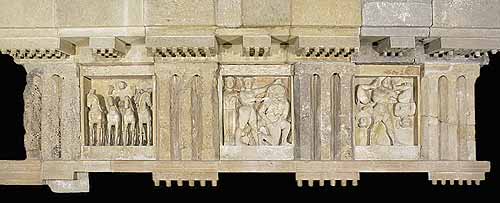
So far we have discussed the
left Metope of Temple C in Selinunte because of its relevance to the mosaic at
Beith Alpha. However, there are three Metopes on the front of the temple. Like
in dreams, artistic representations express themselves by repetitions.
Joseph dreams a dream: "Please hear this dream which I have dreamed: for, behold, we were binding sheaves in the
field, and behold, my sheaf arose and also stood upright; and behold, your
sheaves came around, and bowed down to my sheaf." (Gen. 37:6), and then he dreams
another dream: "Behold,
I have dreamed yet another dream: and behold, the sun and the moon and eleven
stars bowed down to me."
(Gen.
37:9). The two dreams are a repetition of the same instinctual need. Two dreams
are one, as the same concept repeats twice.
The same with Pharaoh's
dreams, and Joseph correctly interpreted : "The
dream of Pharaoh is one" (Gen. 41:25).
In the same way, the three
different images on Selinunte's temple represent the same concept. It is the
same instinctual need of struggle and victory of the Son, just like in Joseph's
dreams.
The first Metope represents
the Chariot of the Sun, which stands for Apollo, the Greek Sun - god and Son -
god, who is the prototype of the Messiah.
The other two representations
are a repetition of the same concept: a Son- god and his heroic deeds.
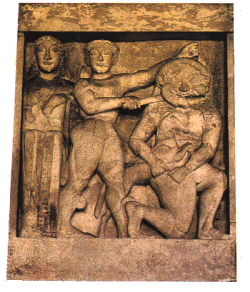
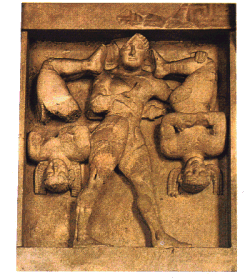
The central Metope tells us the heroic deed of
Perseus slaying the Medusa, and the right Metope tells us one of Heracles�
heroic deeds: his successful struggle with the Cercopes. It is the same
concept, repeated in another representation, and expressed through a different
epiphany: it is the struggle of the hero, Son � god, and his final victory.
The images stare at us from
the highs of the temple, with their archaic enigmatic smile. Through the art of
an ancient and unknown artist, they are communicating, unconscious to
unconscious, the indestructible human drive of the Son to struggle and to
overcome the Father. The entire western civilization flourished under the sign
of this drive: the young heroes, Apollo and the Messiah, representatives and
delegates of all the Sons of the human race.